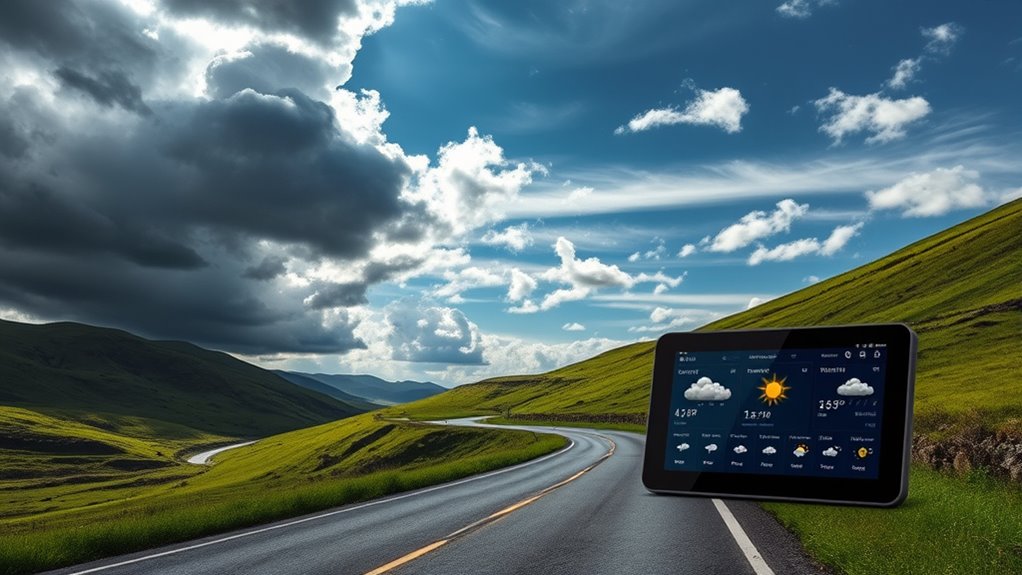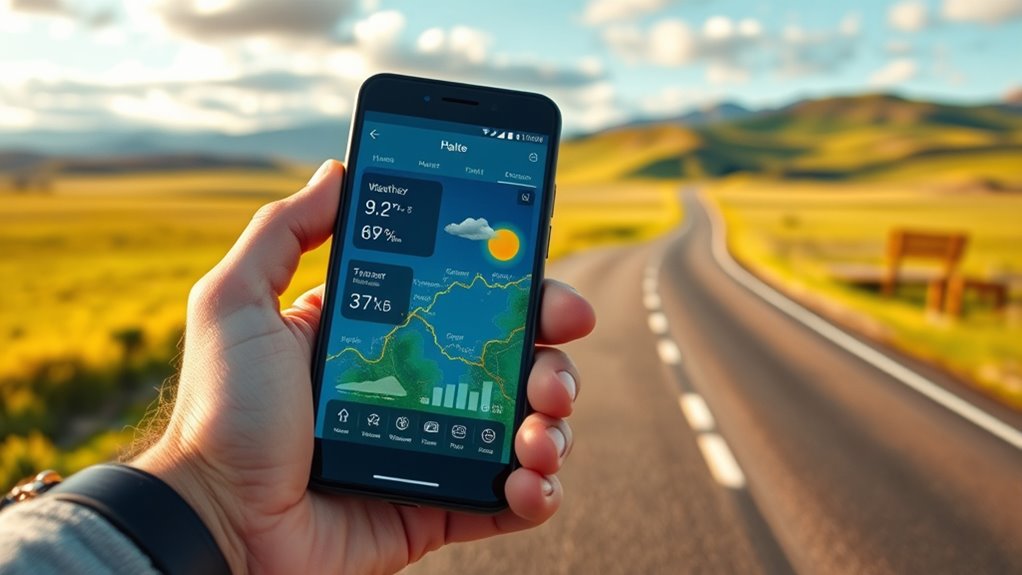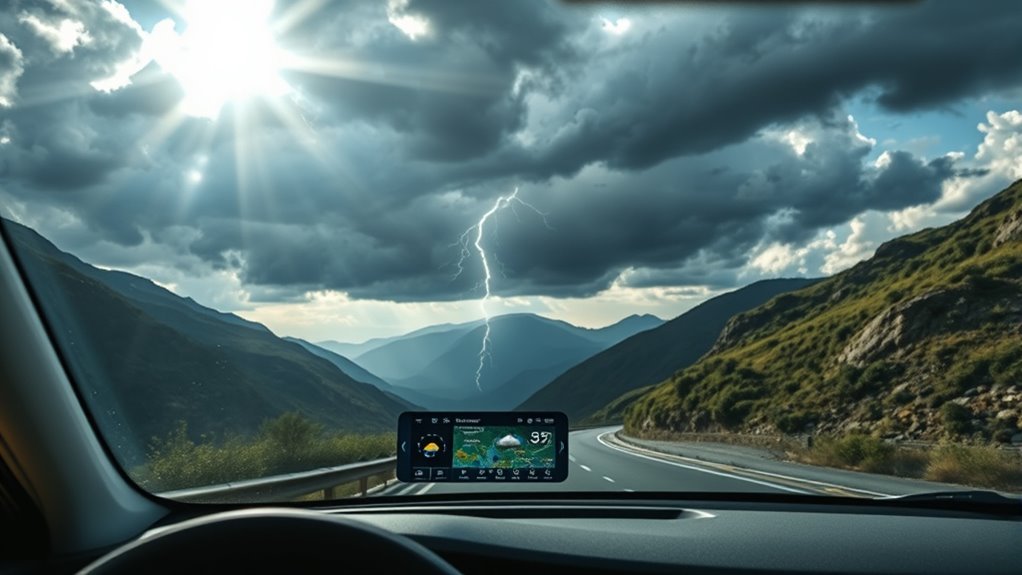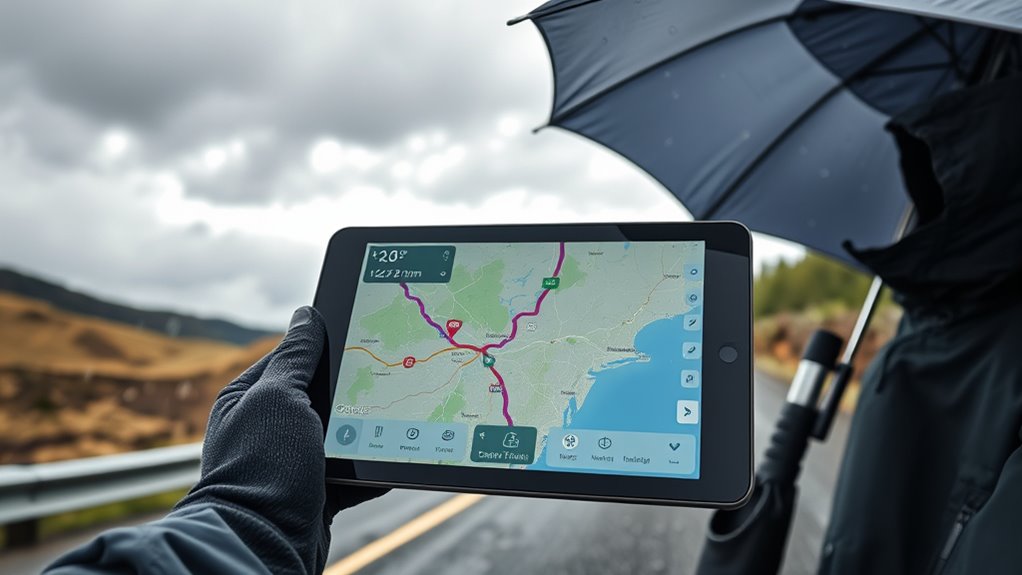To plan a weather-responsive road trip, monitor reliable weather forecasts, air quality, and alerts constantly. Use trusted apps with radar, real-time updates, and severe weather notifications to stay informed. Adjust your route and timing based on forecast patterns and alerts—like delaying departure or taking detours. Prepare your vehicle and emergency supplies for changes, and stay flexible for on-the-fly decisions. Keep exploring for tips to guarantee a safe, comfortable journey regardless of weather challenges.
Key Takeaways
- Monitor real-time weather, forecasts, and air quality to anticipate hazards and adjust your trip plans accordingly.
- Use reliable weather apps with alerts and radar to stay informed and respond promptly to changing conditions.
- Analyze seasonal patterns and historical data to schedule travel during safer weather windows and avoid high-risk periods.
- Incorporate real-time weather alerts into your route planning, making on-the-fly adjustments for safety and convenience.
- Prepare your vehicle and emergency supplies to handle weather-related challenges like storms, icy roads, or heavy rain.
Understanding Weather Data and Forecasts

To plan a safe and enjoyable road trip, you need to understand weather data and forecasts. Pay attention to cloud cover, as it affects visibility and can indicate upcoming weather changes like storms or rain. Clear skies suggest stable conditions, while extensive cloud cover might signal rain or fog, impacting driving safety. Temperature variations are equally important; sudden drops can lead to icy roads, while high temperatures may cause vehicle overheating. Tracking these factors helps you anticipate weather shifts and adjust your plans accordingly. Accurate weather data allows you to prepare for potential hazards, ensuring you stay safe and comfortable throughout your trip. Being aware of weather patterns and their effects can also enhance your overall planning experience. Familiarity with forecast details empowers you to make smarter decisions on the road, avoiding surprises and enhancing your overall journey.
Selecting Reliable Weather Apps and Resources

Choosing reliable weather apps and resources is essential for accurate forecasts during your road trip. Focus on apps that offer thorough weather app features, such as real-time updates, radar imagery, and detailed alerts, to stay informed about changing conditions. Prioritize apps known for high forecast accuracy, as precise predictions help you plan routes and adjust plans proactively. Look for sources that pull data from reputable meteorological organizations and include user reviews to gauge reliability. Avoid apps with limited data or inconsistent updates, which can lead to misleading forecasts. By selecting trusted weather apps with strong forecast accuracy and useful features, you’ll enhance your trip’s safety and planning, ensuring you’re ready for whatever weather may bring along the way. Incorporating accurate weather information from trusted sources can significantly improve your trip planning and safety. Additionally, staying aware of weather‑responsive conditions helps you adapt your route and timing in real-time, reducing the risk of unexpected weather-related issues. Utilizing up-to-date weather data ensures better preparedness and more confident decision-making throughout your journey. Being aware of interior weather conditions inside your vehicle can also help you maintain comfort and safety during your trip.
Analyzing Weather Patterns for Route Planning

Understanding weather patterns is essential for effective route planning, as it helps you anticipate potential delays and hazards. By analyzing seasonal climate trends, you can identify periods when storms, heavy rain, or snow are more likely in specific regions. Incorporate historical weather analysis to recognize patterns over past years, revealing months or weeks with increased adverse conditions. This historical data can also be valuable when considering Ford Tuning modifications, as certain weather conditions may impact the durability and safety of specific upgrades. This insight enables you to plan routes that avoid high-risk areas during certain seasons or times of the year. For example, if data shows frequent snowstorms in winter along a particular highway, you can choose alternative paths or adjust your schedule. Analyzing these weather patterns ensures you’re better prepared, helping you minimize disruptions and stay safe throughout your trip. Additionally, understanding weather-related risks can provide emotional comfort and support during travel planning. Recognizing the seasonal climate trends allows for smarter decision-making, reducing the likelihood of encountering unexpected weather-related issues on the road. Monitoring local weather forecasts regularly can further enhance your ability to adapt plans in real-time and respond to changing conditions.
Timing Your Departure to Avoid Severe Conditions

Timing your departure carefully can considerably reduce the risk of encountering severe weather conditions during your trip. Check local forecasts and plan to leave when weather is clear, especially if storms or snow are predicted. If possible, shift your start time to avoid peak storm hours or heavy rain. Bringing travel insurance can provide peace of mind should unexpected weather force delays or cancellations. Also, pack enough road trip snacks to stay energized, especially if you encounter delays. Leaving early or later in the day often means calmer roads and better driving conditions, helping you avoid dangerous situations. Being flexible with your schedule and staying informed about weather patterns ensures a safer, more enjoyable journey. Proper timing is key to sidestepping severe weather and arriving safely. Additionally, understanding the impact of weather on projectors can help you plan your indoor viewing setup in case of unexpected weather disruptions. Being aware of weather-related travel tips can further enhance your safety and preparedness during your trip. For example, conducting a thorough risk assessment for travel can help you identify potential weather-related vulnerabilities before your journey. Monitoring road conditions and adjusting your route accordingly can also help you avoid hazardous areas. Understanding local weather patterns can give you an added advantage in planning your trip around adverse conditions.
Incorporating Real-Time Weather Alerts During Your Trip

As you travel, keeping an eye on real-time weather alerts helps you stay safe and informed. When you receive an alert, respond quickly by adjusting your plans or rerouting if needed. This proactive approach guarantees you can navigate changing conditions smoothly and avoid hazards. Additionally, understanding sound recording techniques can also help you maintain harmony with travel companions during stressful weather situations. Being aware of financial transaction methods can assist you in managing expenses more efficiently if unexpected costs arise due to weather delays or changes.
Monitoring Weather Updates
To stay safe and avoid surprises, you should actively monitor weather updates throughout your trip. Keep an eye on cloud cover changes, as increasing overcast skies can signal approaching storms or rain. Pay attention to temperature fluctuations, which can affect driving conditions and vehicle performance. Real-time alerts from weather apps or radio broadcasts provide vital information about severe weather, such as thunderstorms or fog. These updates help you decide whether to continue, delay, or reroute your journey. By consistently checking weather reports, you can anticipate shifts and make informed decisions on the fly. Staying vigilant with current weather data ensures you’re prepared for changing conditions, helping you keep safe and enjoy your trip without unexpected surprises. Additionally, understanding air quality indicators can be beneficial if you’re sensitive to pollutants or allergens during your travels. Monitoring air quality levels can help you determine if outdoor conditions are safe for activities like walking or driving. Incorporating weather prediction models can also enhance your planning by providing forecasts with greater accuracy for your specific route.
Responding to Alerts
When a real-time weather alert pops up, it’s crucial to act immediately to guarantee your safety. First, evaluate the severity of the alert and decide whether to continue or pause your trip. If you need to delay, consider grabbing some road trip snacks to stay energized while you reassess your route. Use your weather app to check for updates and potential detours. If conditions worsen, avoid risky scenic stop planning; instead, find a safe shelter or pull over at a designated rest area. Staying alert and responsive ensures you can adapt quickly to changing weather, minimizing hazards. Remember, acting promptly can make all the difference in keeping your journey safe and enjoyable, even when unexpected weather challenges arise.
Safe Route Adjustments
Real-time weather alerts require you to actively adjust your route to stay safe. Being prepared means knowing how to modify your plans quickly, prioritizing road safety. When alerts pop up, consider alternative paths to avoid hazardous conditions. Keep an eye on weather updates and have backup routes ready. Here’s a quick guide:
| Weather Condition | Suggested Action | Priority |
|---|---|---|
| Heavy rain | Detour around flooded areas | High |
| Fog | Use headlights, reduce speed | High |
| Snow or Ice | Avoid steep inclines, delay travel | Very High |
Traveler preparedness helps you navigate storms safely. Adjusting your route promptly minimizes risk and ensures a safer trip for everyone on the road.
Tips for Adjusting Plans on the Fly

Unexpected weather changes can quickly disrupt your plans, so staying flexible is essential. When conditions shift, adapt by considering alternative routes or nearby attractions to maintain your sightseeing flexibility. Keep a stash of road trip snacks handy to stay energized without unnecessary stops. If rain or storms hit, find cozy cafes or indoor attractions instead of outdoor plans. Use weather apps to monitor updates and identify safe spots to pause. Communicate with fellow travelers to decide on the best course of action together. Remember, a flexible attitude helps you make the most of your trip despite surprises.
- Have backup plans for outdoor activities
- Keep a list of indoor attractions nearby
- Adjust your itinerary based on weather updates
- Embrace spontaneous detours for unique experiences
Preparing Your Vehicle and Emergency Supplies for Weather Challenges

Being prepared for changing weather conditions means guaranteeing your vehicle is ready to handle anything the road throws at you. Start with vehicle maintenance—check tire pressure, brake function, fluid levels, and windshield wipers to ensure peak performance. Keep your gas tank full or at least half full to avoid running out in unexpected conditions. Pack emergency supplies such as a first aid kit, flashlight, batteries, blankets, non-perishable snacks, and water. Include a snow brush or ice scraper if traveling in winter, and guarantee your phone is charged with a portable charger. Good emergency preparedness means you’re ready for sudden storms, icy roads, or breakdowns. Taking these steps enhances safety and helps you respond effectively to weather challenges on your journey.
Frequently Asked Questions
How Can I Forecast Long-Term Weather Trends for My Route?
To forecast long-term weather trends for your route, you should look at long-term climate forecasts and seasonal weather patterns. Check reliable weather websites and climate data sources for predictions covering your travel dates. Pay attention to trends like rainfall, temperature shifts, and storm likelihood. This way, you can plan your trip around expected conditions and stay prepared for any weather fluctuations during your journey.
What Are the Best Emergency Communication Devices for Weather Emergencies?
When facing weather emergencies on your trip, you need reliable communication devices. Satellite phones are your best option, providing voice and data connectivity even in remote areas. Emergency beacons are vital for sending distress signals to rescue services quickly. Keep these devices charged and accessible. Together, satellite phones and emergency beacons ensure you’re prepared to communicate during severe weather, increasing your safety and peace of mind on the road.
How Do I Interpret Weather Warnings and Advisories Accurately?
Interpreting weather warnings is like decoding a secret message. Pay attention to weather symbols on alerts—like thunderstorms or fog—and warning color codes, which signal severity: red for danger, yellow for caution. Always read the details carefully, noting the timing and location. This way, you stay ahead of the storm, making smart decisions and keeping safe on your journey. Trust your instincts, but rely on official symbols and codes for clarity.
Are There Specific Vehicle Modifications Recommended for Severe Weather?
When facing severe weather, you should consider vehicle modifications like tire enhancements for better traction and suspension upgrades to improve stability. These adjustments help your vehicle handle icy, wet, or snowy conditions more safely. By upgrading your tires and suspension, you guarantee better control, reduce the risk of accidents, and stay safer during harsh weather. Always consult a professional to choose the right modifications for your specific driving needs.
How Can I Plan for Sudden Weather Changes During Multi-Day Trips?
To handle sudden weather changes during multi-day trips, you should focus on seasonal planning by checking weather forecasts regularly and packing appropriate gear. Keep travel insurance that covers weather-related disruptions for added security. Adjust your route if needed, stay flexible, and have contingency plans in place. Being prepared guarantees you can adapt quickly to unexpected weather, keeping your trip safe and enjoyable regardless of the conditions.
Conclusion
By paying close attention to weather patterns and staying flexible, you’ll navigate your road trip with confidence and peace of mind. Embracing the ever-changing skies allows you to turn potential hurdles into moments of adventure and discovery. Remember, a well-prepared traveler finds beauty in the unexpected, making every journey memorable. So, trust your planning, stay alert, and let the gentle rhythm of the weather guide you to safe and fulfilling travels.








